Tom's Hardware Verdict
MSI’s first microphone, aimed specifically at live streamers and creators, is a solid choice for its target audience thanks to its 24-bit/96 kHZ sample rate. However, if you have no creative intentions outside of strictly live streaming, there may be better options.
Pros
- +
+ Four polar patterns
- +
+ Clear vocal reproduction
- +
+ Easy setup
- +
+ Swivel stand rotates 180-degrees vertically
Cons
- -
No boom arm adapter
Why you can trust Tom's Hardware
The Immerse GV60 marks the first standalone desktop microphone from well-known computer hardware and accessory company MSI. With its first microphone, MSI aims its sights at the live-stream gaming and creator market. As such, the plug & play GV60 has four polar patterns, each explicitly geared towards picking up pristine sound for specific situations like podcasting, capturing vocals, or instruments. Most of all, MSI touts High Resolution Digital Audio with a 24-bit/96 kHz sample rate, 3.2 times more data than the traditional sample rate/bit rate most rival microphones use.
With its premium finish, uniform dial placement and competitive price of $129.99, the MSI Immerse GV60 may be an excellent choice for some, but is arguably overkill for someone solely interested in broadcasting.
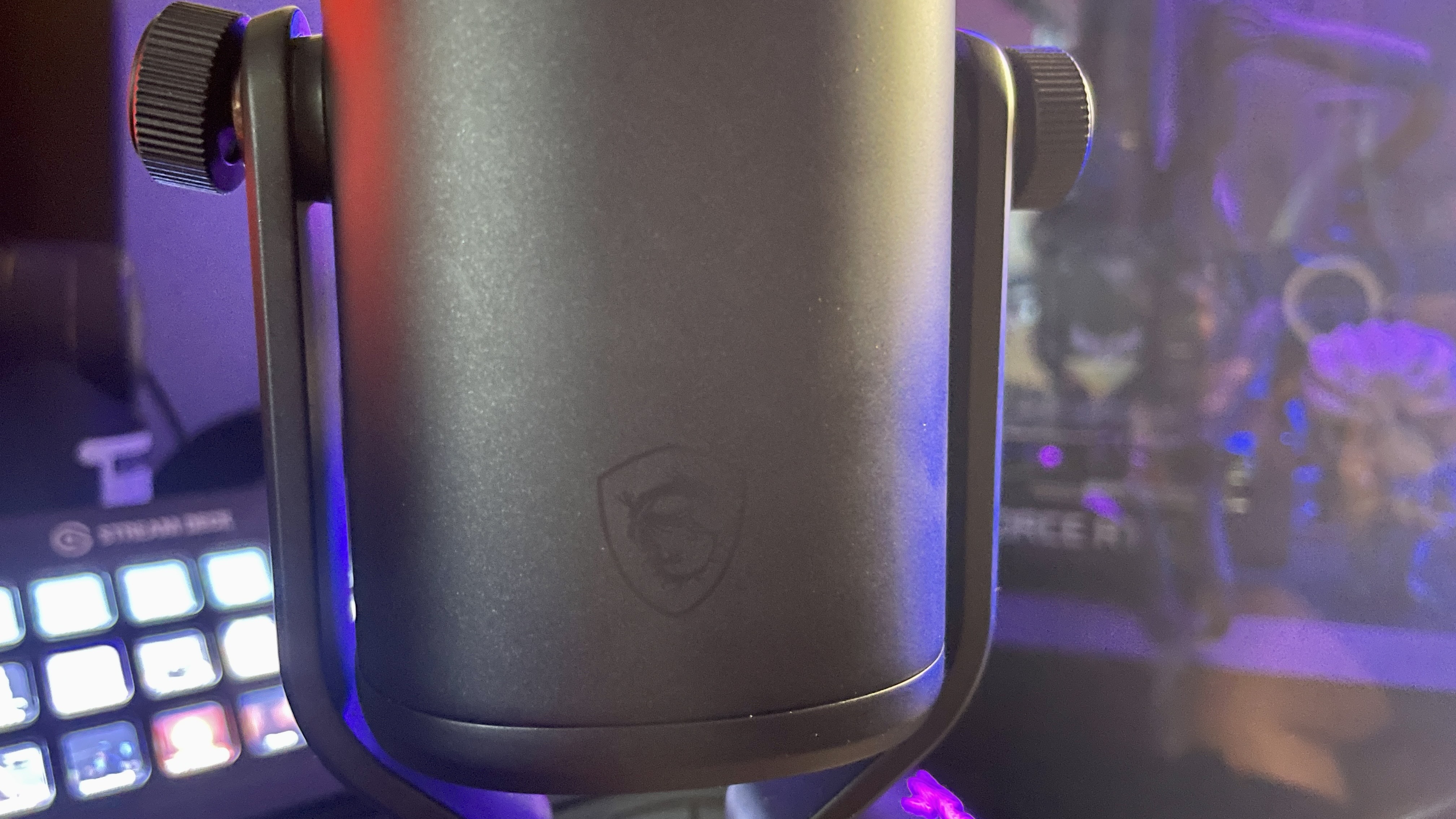

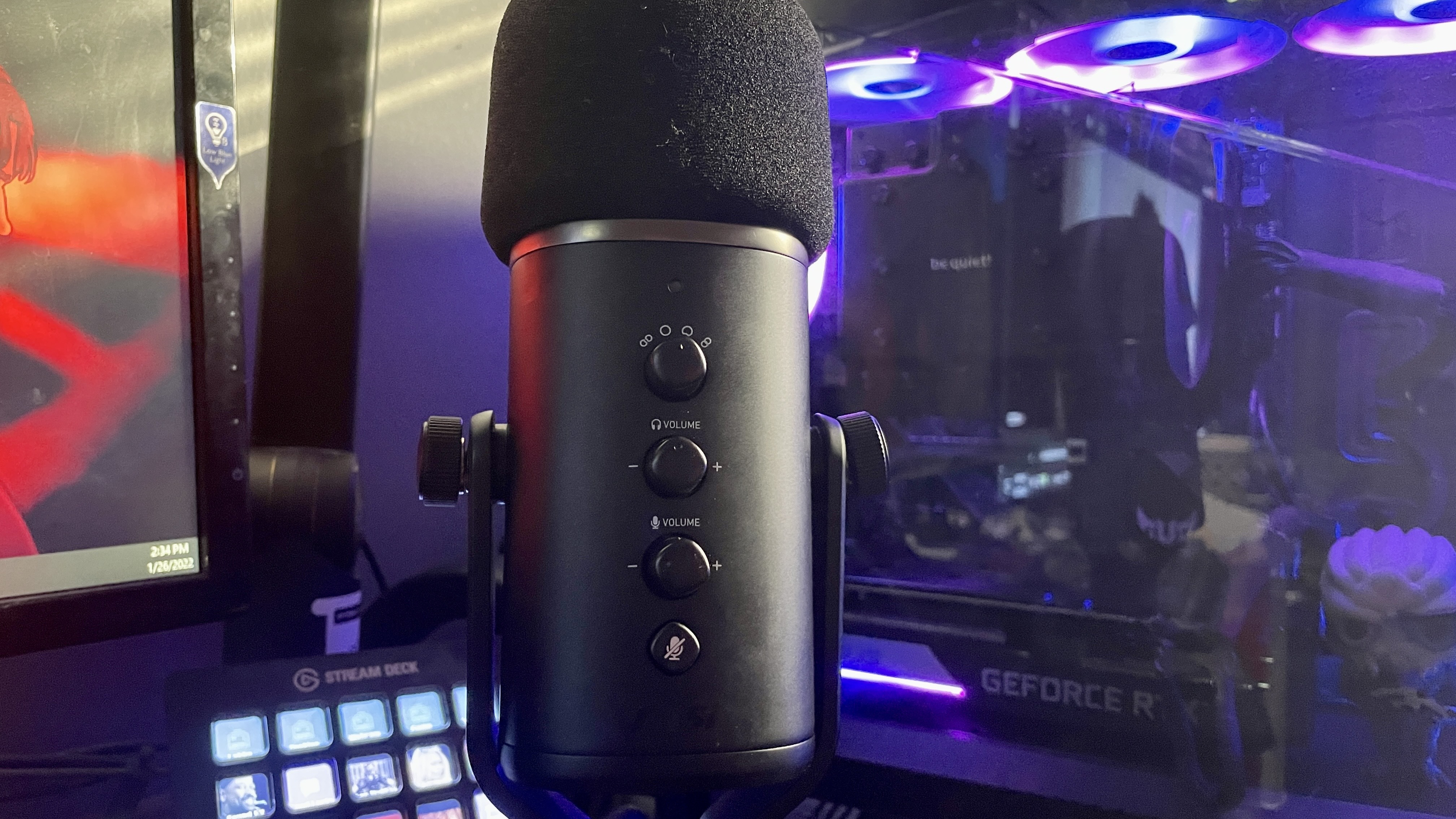
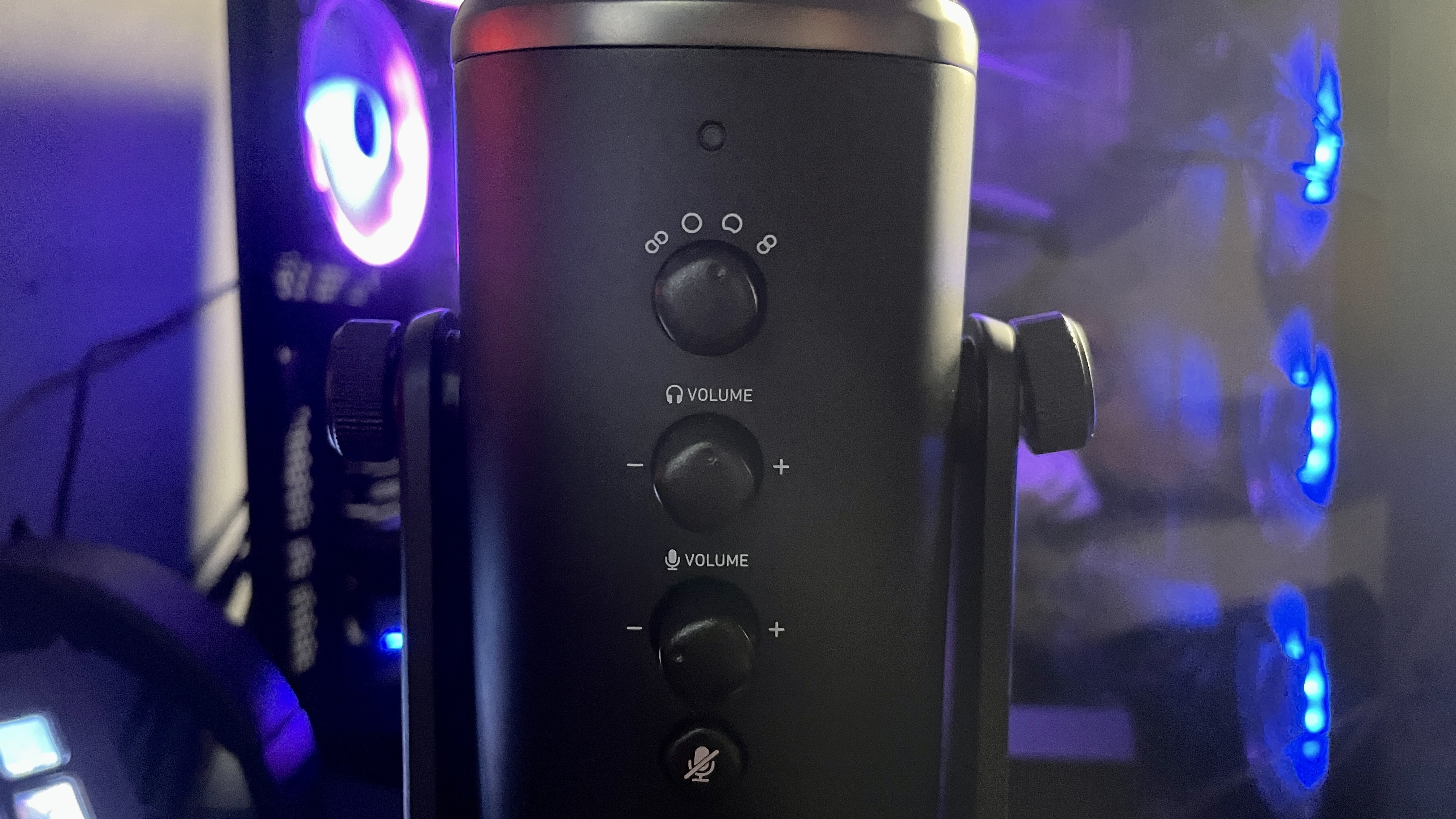
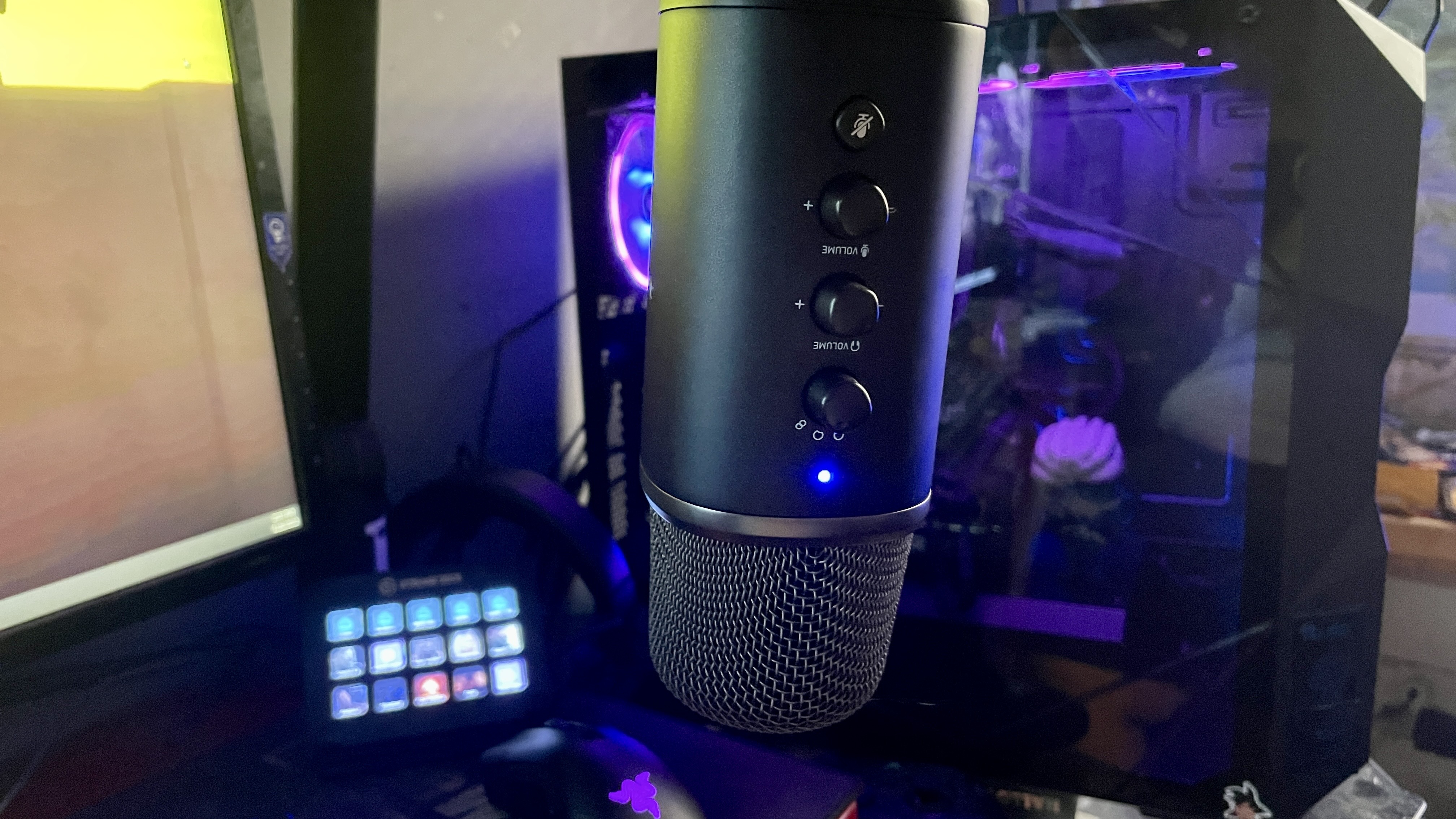
Design of the MSI Immerse GV60
The MSI Immerse GV60 is one of the slickest matte-finished black microphones I’ve ever seen. It has a premium design and monochrome color, making it an aesthetically easy addition to any setup. It’s got roughly the same dimensions as a Blue Yeti, measuring 120 x 125 x 295 inches. However, the Yeti has a more rounded shape than the somewhat boxy build of the GV60. I’m using the Blue Yeti as a comparison point here both because it’s a mainstay for hobbyists and because it’s what I had on hand when writing this review.
The GV60 is also twice as heavy as a Blue Yeti, weighing in at 2.4 pounds. Although these things make the Blue Yeti easier to hold, I still prefer the thicker build of the GV60. The design allows all control dials to be alongside each other, unlike on the Blue Yeti, which finds its dials distributed along its front and back. The GV60’s dials, which are all front and center, include a single knob to adjust between polar patterns and two knobs for headphone and microphone volume, respectively.
Having all the dials on one side makes adjusting the sound on the fly much easier on the GV60 as opposed to the Blue Yeti, which will have you making unwanted adjustments to the position of the mic to access certain dials. There’s also a dedicated mute button at the bottom of the mic that pushes in and out. When the mute button is active, the mic’s blue light, which indicates that it’s on, will turn red. Since the MSI Immerse GV60 utilizes no software, it’s less of a plus to include all these physical buttons and more of a necessity.
Underneath the microphone is where you can find its 3.5mm headphone jack and USB-C port, located next to its built-in threading. Its 10 foot (3m) USB-C to USB-A cable is lengthy and comes with a rubber tie at the end for cable management. The GV60 comes attached to a swivel stand alongside a separately packaged pop filter that fits on the top of the microphone. The stand can swivel the microphone 180 degrees vertically and securely hold it in place. I was never afraid of it falling or spinning out of control. The stand uses two screw caps in order to keep the mic in place. As a result, both ports are easy to reach when the mic is on a stand. The pop filter is made of foam and effortlessly slides on and off. It has its uses, which I’ll discuss more below, but aesthetically speaking, I like to keep it off.
MSI Immerse GV60 Specs
| Frequency Response | 20Hz - 20,000 kHz |
| Sample / Bitrate | 24- bit/96 kHz |
| Polar Patterns | Stereo, Omnidirectional, Cardioid, Bidirectional |
| Headphone Amplifier Impedance | ≤ 2.2k Ohms |
| Cable length | 10ft/3m |
| Dimensions (w/ stand, LxWxH) | 10.63 x 4.33 x 4.33 inches/270 x 110 x 110 mm |
| w/o stand | 7 x 4.2 x 4.2 inches/177 x 106 x 106 |
| Weight | 2.42 lbs/1100g |
| w/o stand | 3.49 lbs/1586g |
| Warranty | 1-year |
Sound Quality on the MSI Immerse GV60
MSI says the Immerse GV60 is able to reproduce high-resolution digital audio as a result of its higher-than-usual sample rate. Most microphones utilize a sample rate commonly found in CDs, 16bit/44.1Hz. According to its spec sheet, the MSI Immerse GV60 uses a studio-grade 24bit/96kHz sample rate. And during my use, I did find the audio to have more clarity than my 16-bit/48kHz Blue Yeti, and that’s coming straight out of the box without any subsequent software tweaks.
Get Tom's Hardware's best news and in-depth reviews, straight to your inbox.
MSI included four polar patterns on the Immerse: cardioid, bidirectional, stereo, and omnidirectional. Omnidirectional picks up sounds from all directions and is better for capturing environmental noises than voices. When I tested this pattern, despite being close to the mic, it ended up picking up my surroundings better than my gibberish. When it did come through, my voice sounded a bit muddy. The bidirectional pickup pattern utilizes the front and rear of the microphone to pick up sound and is best suited for instruments or when two individual voices are present.
Stereo uses the left and right channels of the microphone to pick up noises and is meant to produce a realistic, general sound for capturing a choir or someone singing. I came through fine when testing my voice under this pattern, but it sounded like playback from an old camcorder. I’m sure the stereo setting is useful under certain circumstances outside its recommended use. Maybe for a true-crime podcast recording. However, I never found a practical use for the stereo polar pattern.
As a live streaming microphone, however, the caridoid setting is the most important, as it utilizes the front of the microphone to pick up voices and block out ambient noises. There was a noticeable jump in sound quality from my Twitch streams compared to my usual set-up with the Blue Yeti. Viewers immediately told me that I sounded much crisper than usual, and I recognized the difference in clarity when I watched the playback of the stream later. In Streamlabs OBS, I usually use a noise gate and noise suppression filter. But with this new microphone, I no longer needed to use a noise gate.
However, a noise suppression filter will still be necessary in order to isolate sounds like the clicks of your mechanical keyboard. You still may hear slight sounds from the impact your fingers make on your desk, even if your mic is on a boom arm like mine is. During my morning meeting for work, I couldn’t use the same software filters I’d use in Streamlabs OBS. So the GV60 picked up every semi-truck honking through traffic outside my window even though the mic volume was fairly low.
Speaking of OBS, live broadcast software similar to Streamlabs and platforms like Twitch only support or recommend 48Khz audio. They’re compatible with 24-bit/96 kHz audio just fine, but the audio will be downsampled nonetheless. This makes the GV60 and its high-def digital audio more practical for a variety of creator uses, instead of the singular use of live streaming that some may be planning to use it for.
There’s a dedicated control dial to adjust between the four polar pattern options on the fly. It’s a bit difficult to change that specific dial without holding onto the microphone itself, which may give off scratchy feedback in the act. In contrast, adjustments for the mic and headphone dials slide easily to the left and right.
The bottom of the GV60 houses the 3.5mm headphone jack and its USB-C to USB-A port. The jack is for real-time monitoring, which provides zero latency during playback, so you can instantly monitor your voice for volume and clarity. The built-in threading on the mic’s bottom center is for an adapter that connects the mic to a five-eighths inch boom arm. The Immerse GV60 fit into my Blue Compass boom arm fine with an adapter attached. When attached to a boom mic, both the port and jack are in plain view and easily accessible.
Accessories and Compatibility of the MSI Immerse GV60
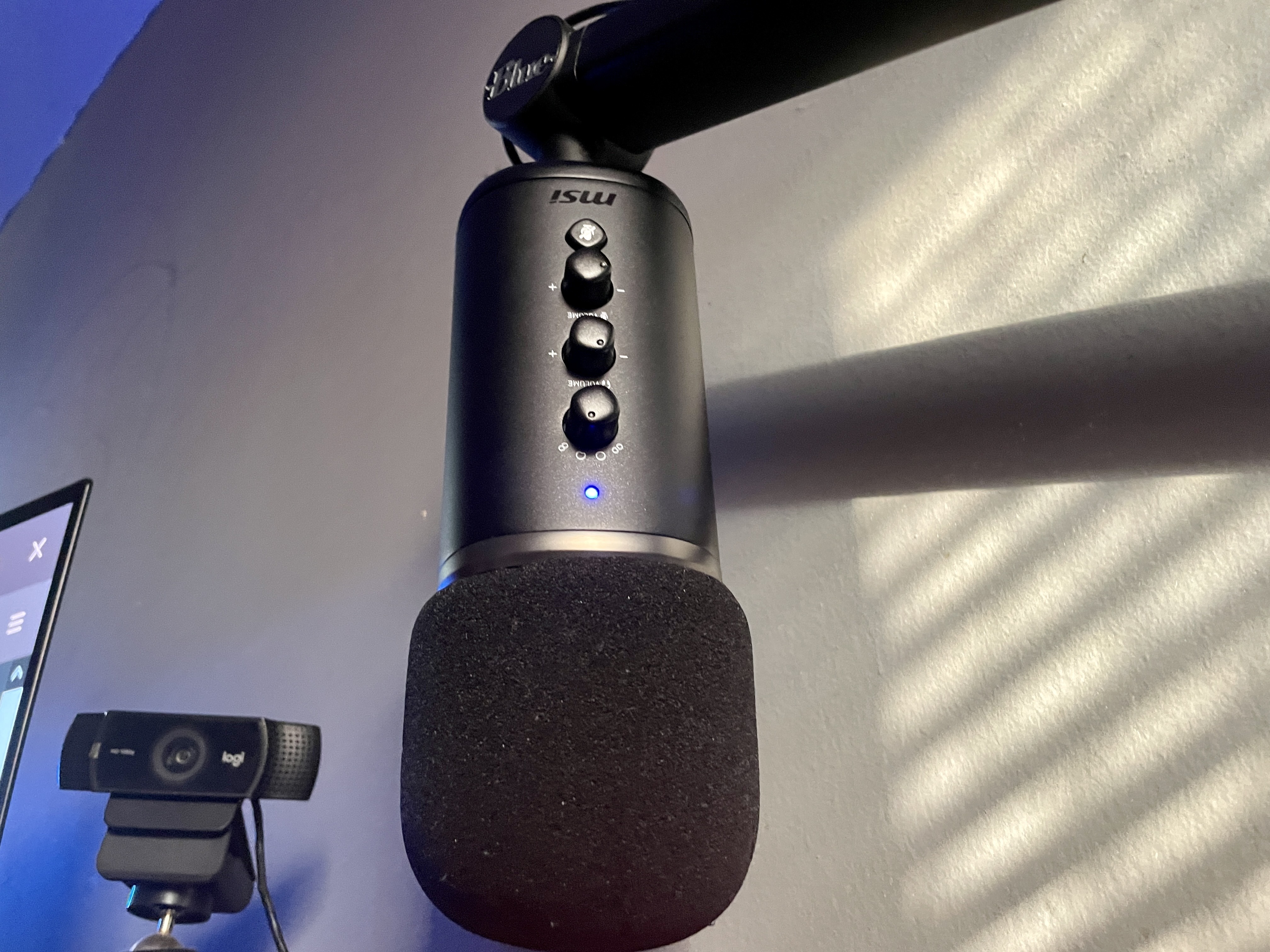

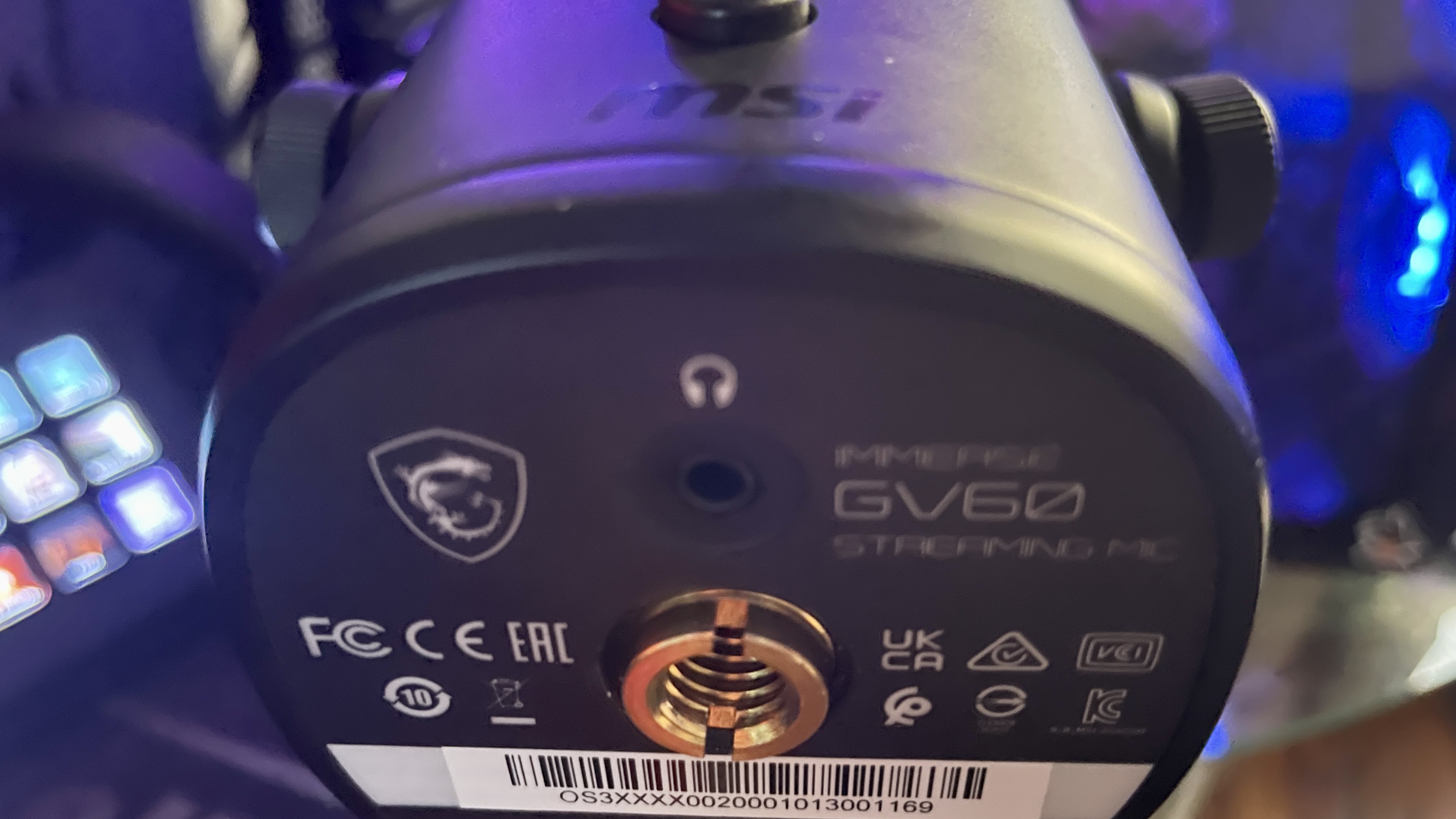

The MSI Immerse GV60 comes with a swivel stand that can adjust the microphone up or down with ease. Two screw caps keep the microphone in place and swing it up and down. That makes it a more helpful stand than some others, which is great if you’re not interested in using a boom arm. That said, it is better to move microphones as far away from your keyboard as possible when recording.
Unfortunately, there was no boom arm adapter included in the box. And since my original adapter was stripped inside my Blue Yeti, I had to wait a few days for a new one to arrive before attaching the GV60 to my Blue Compass. Once it did, the USB-C to USB-A wire lined up nicely with the boom arm without much effort. I also tied down excess wiring with a rubber tie. But it was disappointing that a boom arm adapter was not included in the packaging.
The GV60 also includes a pop filter that comes in handy to hide mechanical keyboard clicks entirely if you use a noise suppression filter. I used the microphone both with and without its pop filter, and during playback recordings, I found some differences. With the pop filter on, a bit less ambient noise crept in during playback. Certain harsh consonants starting with the letter “P” clipped the audio in the Audacity voice recorder app when the filter was off and the Project Rate was set to default (44100 Hz). When I tried those exact words with the filter on, there was no clipping. But when the Project Rate in Audacity was set to 96000 Hz, there was no clipping at all with or without the filter. Regardless, it’s nice to know that the filter does indeed make a difference and isn’t a gimmick.
Bottom Line
The MSI Immerse GV60 is a great choice for its intended audience. Out of the box, without any sort of alterations, the GV60 provides excellent clarity. In fact, audio from the mic fresh out of the box had much more clarity than my previous setup with a Blue Yeti and an assortment of Streamlabs OBS filters.
However, most broadcast software and platforms like Streamlabs and Twitch recommend 48Khz, so the boost in sample rate may only be beneficial if you plan to use the microphone outside of streaming. Software like Streamlabs will support 24-bit/96 kHz sample/bitrate just fine, but keep in mind audio will be downsampled. You will also need software to deliver a proper stream without any outside noises.
If you’re a stickler about microphones picking up keyboard clicks, as the GV60 does, there are workarounds, such as the pop filter that comes with the package. Another workaround would have been to include a boom arm adapter as an incentive to get the microphone away from the same surface as your keyboard, but I had to buy one myself since MSI doesn’t include one in the box.
All of these issues aside, the MSI Immerse GV60 is a solid choice when compared to similar 3.14mm capsule mics like Blue Yeti or HP’s HyperX Quadcast S, both of which tap out at a 16-bit/48kHz sample rate at relatively the same price. Even other options like the Razer Seiren V2 Pro, a cardioid microphone with 24-bit/96 kHz sample/bitrate, are bogged down by overly complicated software. Another cardioid option with a 96 kHz sample/bitrate, the Neat Bumblebee II may be cheaper but is less suited for game streamers.
But we can only recommend the MSI Immerse GV60 to streamers who intend to use their microphone for other creative applications outside of gaming. There are cheaper options that will get the job done if you’re just a streamer. Pick up the GV60 if you’re a streamer that also may need high def audio reproduction for other creative ventures.

Isaac Rouse is a staff writer at Tom's Hardware. He reviews laptops and various gaming peripherals.